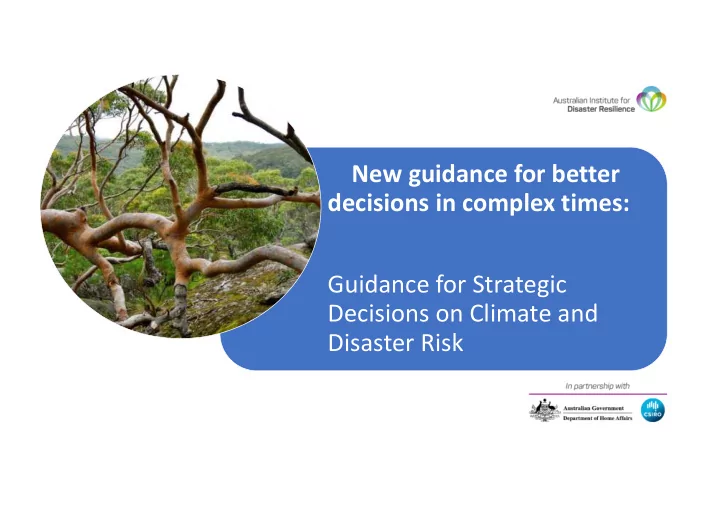

New guidance for better decisions in complex times: Guidance for Strategic Decisions on Climate and Disaster Risk
The context ? ? ? ?
Ramana James and Georgine Roodenrys: bit.ly/DisasterRiskVideos
The guidance https://knowledge.aidr.org.au/resources/strategic-disaster-risk-assessment-guidance/
Adaptive decision making and learning What ought to be? What is? What could be? What can be!? 5 |
Adaptive decision making and learning Learning 6 |
Framing and scope of the Guidance The guidance complements existing decision-making processes and the methods, tools and practices used by decision makers Infrastructure Australia’s Assessment Framework 7 |
Guidance on Systemic Risk Governance Systemic risks Systemic risks are risks that could trigger severe instability or collapse of an organisation, industry, economy or system. These are often referred to as ‘strategic risks’ to highlight their relevance to the strategic direction of an organisation, sector or region. 8 |
Guidance on Systemic Risk Governance Diagnosing constraints • Need knowledge to choose and implement an option • Need to accept the knowledge and want the outcomes ( values ) • Need to be allowed to implement the option to achieve the outcomes? ( rules ) 9 |
Guidance on Systemic Risk Governance Collective impact initiatives: 1. Setting a common vision and agenda 2. Working out how to realise this: • mutually reinforcing activities • shared measurement system, and • continual communication 3. Identifying boundary-spanning organisations and networks 10 |
Guidance on assessing vulnerability 11 |
Guidance on assessing vulnerability Systems thinking 12 |
Guidance on assessing vulnerability People value things differently in stable times versus times of disruption Values analysis Value relationships and tensions
Guidance on assessing vulnerability Deconstructing disaster 14 |
Guidance on scenarios 15 |
Guidance on scenarios Types of scenarios Scenarios Predictive Explorative Aspirational Normative What will happen? What could happen? What should be? What can happen? Trend Descriptive Preserving Transformative What if? Strategic Problem focused Decision focused Scenarios to support robust decision making 16 |
Guidance on Prioritisation 17 |
Guidance on Prioritisation The prioritisation framework Asset Community Restoration Value at risk: wellbeing - The product of Climate & exposure to an event Socio- Disaster and vulnerability to Economic economic Risk impact Value potential: Uplift disruption Reduction - The latent potential Prioritisation for increased value Environment from DRR and climate Service & heritage resilience investments Performance disruption 18
Guidance on Prioritisation Mapping outcomes from the prioritisation framework +ve Could Do Must Do Might Do Should Do +ve -ve -ve
Guidance on Prioritisation Value creation through DRR investments 3 Opportunities exist to create value for a range of Value beneficiaries from investment creation & in DRR initiatives 1 Service new Need funding 2 4 Costs and Community Risks and Beneficiaries 20 |
Guidance on Prioritisation Charting the course for Value Creation and Capture and for realising funding Rapid Value Value Governance Integration Financial Risk analysis Placement Funding delivery Creation Capture models & to current instrument and rating of financial from financial Assessment Assessment Implementation revenue development agency instrument instrument streams review placement 1 2 5 6 3 4 7 8 Stages Capital and Value Capture Funding Strategy Funds realisation 12 outcomes 21 |
Take home messages The drivers of climate and disaster risks (C&DR) are systemic – we need to change how we think about, assess and manage these risks This means we need to shift from: - ‘ learning to do BAU better ’ to ‘ collectively learning to do differently ’ - seeing C&DRs as environmental or EM issues to treating them as central - delaying decisions due to uncertainty or contestation to building our capacities in systems thinking, values literacy & using scenarios so we can make decisions in spite of this Acknowledging we are all vulnerable to systemic risks we can begin to act on our immense capacities to collectively overcome these challenges 22 |
Recommend
More recommend